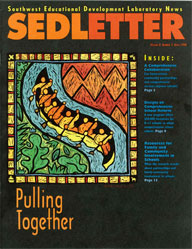Editor's Note: Pulling Together Broader Views of Schools
Consider "comprehensive schools" designed to serve the whole child and his or her family. These comprehensive schools support academics by offering a broad range of health and social services to students and their families. They often match educators with nontraditional partners for education-clinicians, service agency professionals, parents, and businesspeople, for example.
Do such approaches work in schools? Several public schools in Albuquerque, New Mexico, are finding out. SEDLetter Editor Mimi Mayer profiles the partnership program that helped make these comprehensive services a reality in "A Comprehensive Collaboration." Read it to decide if such partnerships can improve schools while pulling together a community — and to understand why this partnership was named a model program by the US Department of Education. To learn what the research says about the efficacy of partnerships and parent-community involvement programs, see "Resources for Family and Community Involvement in Schools."
"Comprehensive schools" takes on another meaning with the article "Designs on Comprehensive School Reform." Joan Buttram, Chief Operating Officer of the Southwest Educational Development Laboratory (SEDL), describes a new federal initiative that provides incentives to states and K-12 schools that initiate comprehensive school reform programs. In this case "comprehensive schools" applies to school reform models that pull together programs and resources to support students at "all grade levels and address all core academic subject areas, instructional practices, and school organization," Buttram writes. Introduce yourself to the new Comprehensive School Reform Demonstration (CSRD) program with the article then visit SEDL's CSR Web site at www.sedl.org/csr/ to learn if it's right for your school.
Research as well as policy can also shape school reform. You'll find several new research publications that may help you and your school through the process in "Resources for Family and Community Involvement in Schools." We hope you find this information useful and relevant.
Next Article: A Comprehensive Collaboration

